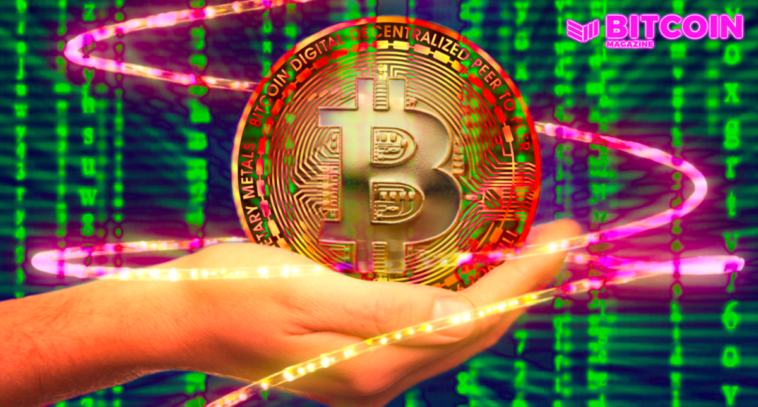A heartfelt message from a father to his children in regards to the life-energy saving properties of Bitcoin.
Dear Jen and Matt,
As we reflect on Independence Day this year I was inspired to write this letter. If you’re going to put your life savings into something that will hold its value — energy — across time and space it helps to understand your choices.
You can think of each hour of your labor — your energy — as having been traded for U.S. dollars when you work. So you’re storing your labor in U.S. dollars. All else being equal, if I work an hour and I’m able to save the money I was paid for that hour, I want that money to keep its value over time for later spending.
CEO of New York Digital Investment Group, Ross Stevens, calls the money you trade for the work you do as your “life force.” I want to save my life force or my parent’s life force for spending or investing in those things I value most. If I wait a year or two or ten to spend it, I want it to hold value throughout that time period.
U.S. dollars do that very poorly.
Our labor can also be viewed as a form of energy that we most often store in the form of money. Anything that stores and preserves that energy is preferable to anything that leaks or dissipates energy. Something that holds 99% of its value over time is better than something that loses its value by 5-10% every year.
This is the basic dilemma which all workers face today in every country.Every fiat currency in the world is being inflated to zero which is another way of saying it’s leaking energy. It’s also our government and central bankers quietly robbing us of our life force or energy every time they flood the system with more dollars… without anyone realizing that’s what they’re doing.
So energetically what are your options?
Option 1:
You can hold your energy or life force or savings in fiat currency like the U.S. dollar. Right now the interest paid on U.S. dollars is essentially zero and the real interest rate is double-digit negative when you consider the current level of the Federal Reserve’s money printing. That means if you had $10,000 in your bank on January 1, 2020 and you didn’t spend any of it but only thought of all the things you could buy with it, that same $10,000 has less purchasing power today, meaning you can now buy way less with your $10,000 than you could have in 2020.
If you go back to the creation of the Fed in 1913 you realize that storing your life force in U.S. dollars is very inefficient. Because of inflation, one U.S. dollar today has lost about 98% of its purchasing power since the Fed was created.
However, that doesn’t make it personal enough to fully grasp how undesirable this is. Stated in terms of life energy or life force, it means the Fed and our government has stolen 98% of the life force or energy produced by workers since 1913. Governments and central bankers are horrible allocators of capital and particularly poor at preserving our life energy across time and space. And as bad as that sounds, there are central bankers and governments in other parts of the globe that are far worse than ours.
Option 2:
Another option is to make investments in companies like Apple, Google, Facebook or Netflix in hopes that they increase in value faster than the Fed devalues or debases the U.S. dollar. That means we have to gamble with our life force. Right now, the most sophisticated investors in the world will tell you we are experiencing asset inflation because of the Fed’s inflationary monetary policy. That means more people are taking their life energy or life force and investing it (gambling really) in the stock market in hopes it will keep pace with the currency debasement. This has become particularly noticeable to many more people since March of 2020. However, what people don’t realize about this strategy is it requires you to put your life energy at risk in order to preserve it’s buying power over time. And it also treats our most vulnerable (those with no wealth) worse than those who have money to invest.
Option 3:
You can also invest your money, life energy or life force in commodities like gold or silver. Because of its relative scarcity, the inflation rate of gold is about 2% per year. That means that over a 25-year time frame it will have lost 50% of its value. Much better at storing energy than the U.S. dollar but still not very impressive. Real estate is another option for storing monetary energy which I’ll write about separately in another letter.
Option 4:
Today you have a fourth option that is orders of magnitude better than anything before it: bitcoin.
Money Is A Battery
Perhaps a better way to think about money as energy is to consider an everyday analogy that we understand all too well: the battery in our cell phone or tablet computer. I’m sure most of us prefer a cell phone with a long battery life for the same reason I prefer a monetary unit that has a long battery life. Something that stores energy (purchasing power) and has almost no leakage over time is much more desirable as money than something that loses its charge (value) quickly.
If I store my life energy in the Argentinian peso, its energy will deplete by 50% in one year thereby making saving for retirement “mission impossible.” Storing my life energy in the U.S. dollar is certainly preferable to storing it in the Argentinian peso. However, we are living in an age where every currency is rapidly losing its value. All fiat currencies are in a race towards zero. There has never been a period in human history where fiat currency wasn’t debased into worthlessness.
Enter bitcoin. Ross Stevens explains this problem very clearly in an interview he gave in May, a portion of which I transcribed:
The period of March to August of 2020 was a tough period for me. What struck me was the profound unfairness of the fiat monetary system. The profound unfairness of the impact of well-intentioned central bank activities. Well intentioned; but the results were profoundly unfair. The explosion of wealth inequality was breathtaking. And we haven’t seen anything yet. The explosion of business inequality. The system favors the big companies over the small companies. As an individual, if you did not own assets going into 2008-09 the American dream got pretty far away. You were left far behind. But if you didn’t own assets going into March of last year the American dream is gone man. It is a speck in the distance. And that’s terrible. That’s not us. That’s not our country. We’re the greatest country in the world.
We’ve had enormous inflation in the American dream…
We can define real estate and retirement as the two pillars of the American dream. When the Fed comes in and buys Treasuries and MBS [mortgage backed securities] they are buying houses. So if you owned a house already; golf clap. But if you didn’t? Too bad. That’s not fair.
What’s a private version of Social Security? It’s an income annuity. Ten years ago with $1,000,000 you could get $100,000-$120,000 per year in income. Today? You might have $30-40,000 per year in income. Retirement is becoming largely unaffordable.
But the biggest shift in my thinking during that period was about cash in people’s portfolio. There is a disproportionate impact of cash in a poor person’s portfolio and non-poor portfolio. With someone who has a net worth of $10,000 the percentage of their portfolio that is cash is 90-95% or 100%. If someone has $5,000 net worth it’s probably 99-100%. If they have $1000 net worth it’s the same. Someone with $1,000,000 maybe that percentage in cash is 10, 20 or 30% but not 90-95%. And the problem with that is cash is radically depreciating in value. Cash is no longer an asset, cash is a liability. And the more the Fed prints, the more the non-cash portion of the wealthy person inflates and the cash portion deflates. The poor have few or no non cash assets. They are SOL. That is a terrible, terrible result.
Bitcoin has been called wealth insurance. Who needs insurance the most of any kind? It’s the most vulnerable people. The most vulnerable people need the wealth insurance.
And it’s also life insurance as well. Not in the sense that there is big payout if you die. It’s more in the sense of big payout while you live. MM: A way to store your life’s energy.) It’s not a payoff in fiat money, it’s a payoff in personal sovereignty. It’s freedom and dignity. And if all you own is fiat and that’s a melting ice cube… you lose your dignity every single day the Fed prints. And that is not okay.
The good news is we finally have a monetary system governed by rules not rulers. And it’s open to all. So everybody gets to choose; which is great. You can stay in the fiat standard where a very small group of people get to print an unlimited amount of new units of money (just not for you) or you can opt into the bitcoin standard in which no one gets to do that – including you.
You can decide which is more fair.
Money at its core is simply energy and the bottom line is this: Bitcoin is a highly effective way of storing your life energy. Fiat is a horrible way to store your life energy. Fiat wastes energy. Bitcoin reduces monetary entropy or waste to zero. No one’s forcing you to hold bitcoin, but when you look at money through an energy lens the choice is clear.
Love,
Dad
If you would like to reach out to the author please email him at [email protected]
This is a guest post by Mark Maraia. Opinions expressed are entirely their own and do not necessarily reflect those of BTC Inc or Bitcoin Magazine.





 BTC-USD
BTC-USD  ETH-USD
ETH-USD  LTC-USD
LTC-USD  XRP-USD
XRP-USD